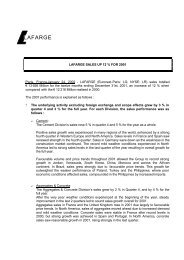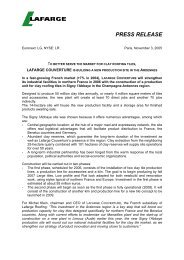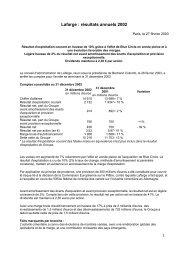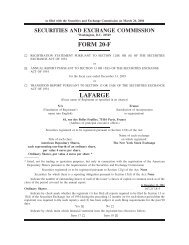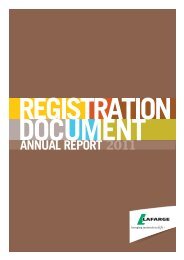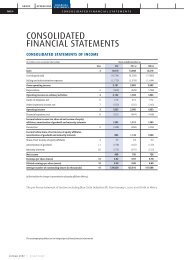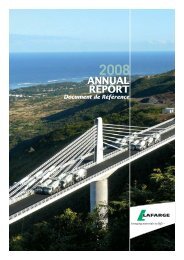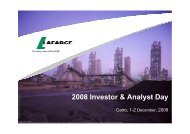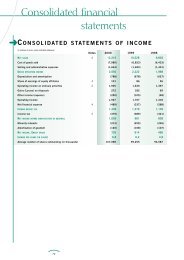2005 Sustainability Report - Lafarge
2005 Sustainability Report - Lafarge
2005 Sustainability Report - Lafarge
Create successful ePaper yourself
Turn your PDF publications into a flip-book with our unique Google optimized e-Paper software.
Optimizing our consumption<br />
of non-renewable raw materials<br />
Most of <strong>Lafarge</strong>'s products originate from minerals extracted from quarries,<br />
such as limestone, gypsum rock and clay. To reduce our consumption<br />
of limited natural resources and to extend the life of the quarries, we<br />
have made the use of alternative materials a strategic priority. Our longstanding<br />
efforts to use these alternatives were continued and the priority further emphasized<br />
during <strong>2005</strong>. All our business activities were involved to varying extents.<br />
INCREASED USE<br />
OF ALTERNATIVES<br />
TO QUARRIED MATERIALS<br />
During <strong>2005</strong>, <strong>Lafarge</strong> used about<br />
451 million tonnes of raw materials,<br />
92% of which were mined from quarries.<br />
Gypsum can be produced from natural<br />
gypsum mined from quarries or from<br />
synthetic gypsum. Synthetic gypsum is<br />
a by-product of the process used to treat<br />
flue gas from fuel or coal-fired power<br />
plants. The sulfur dioxide contained in<br />
the flue gas reacts with the limestone<br />
or the lime to produce gypsum. At<br />
present, almost half the gypsum used<br />
by the Group’s Gypsum business is<br />
synthetic gypsum. With more than<br />
50% of the raw materials derived from<br />
alternative products, the activity<br />
(plasterboards only) comfortably<br />
reached its objective of 45% in <strong>2005</strong>.<br />
JEAN-PAUL JEANRENAUD<br />
WWF<br />
To increase the level of recycling of<br />
plasterboard and construction and<br />
demolition waste, efforts must now be<br />
focused on improving waste sorting and<br />
transportation.<br />
PROMOTING<br />
WASTE RECOVERY<br />
The Cement business promotes the use<br />
of waste as an alternative to raw<br />
materials and fossil fuels. In response<br />
to this challenge, the Cement business<br />
has set up the Resource recovery unit<br />
to develop innovative solutions and<br />
ensure that the environment and<br />
regulations are respected. A team of<br />
professionals at Group and Business<br />
Unit level is acquiring new expertise<br />
and developing innovative ways of<br />
turning this priority into a reality.<br />
10.5%<br />
1%<br />
USE OF ALTERNATIVE<br />
MATERIALS<br />
(as a percentage of total material consumed)<br />
51.1%<br />
9.8%<br />
1.3%<br />
50.5%<br />
● Cement<br />
● Roofing<br />
● Gypsum (boards only)<br />
10.0%<br />
The Cement performances are linked<br />
to an increase in the use of fly ash<br />
and slag.<br />
Benchmark> Out of the 8 members<br />
of the WBCSD CSI that disclose<br />
alternative material utilization rates,<br />
<strong>Lafarge</strong> registered the best<br />
performance. The Group's rate<br />
is 0.1 point higher than its next<br />
best competitor, a local player<br />
operating in a highly developed<br />
country, and 1 point higher than<br />
the next best global player.<br />
0.9%<br />
03 04 05<br />
WWF welcomes <strong>Lafarge</strong>'s efforts to provide both vision and results regarding its sustainability approach<br />
in this year's report. We welcome the presentation of positive examples of stakeholder engagements<br />
and environmental initiatives, as well as the clarified positions on a range of lobbying issues.<br />
Nevertheless, there remains scope for <strong>Lafarge</strong> to improve by setting more environmental performance<br />
targets to give a clearer indication of how they aim to achieve their vision.<br />
We would like to see a more detailed position on carbon trading and a more precise reporting on<br />
actions that have been initiated in relation to “industrial ecology”. In particular, <strong>Lafarge</strong> should<br />
openly acknowledge the importance of the persistent pollutants issue which is increasingly significant<br />
to both stakeholders and regulators.<br />
It should also explain the issues surrounding the use of alternative fuels and alternative raw materials<br />
and what is being done to prevent any environmental or health impacts.<br />
50.6%<br />
PANEL<br />
LAFARGE | <strong>2005</strong> SUSTAINABILITY REPORT | PAGE 19




